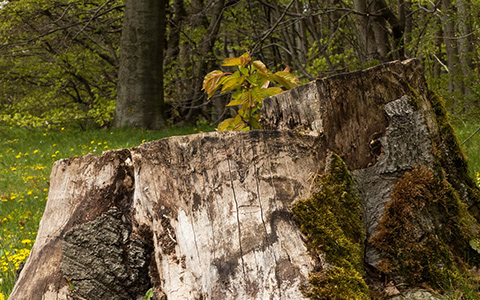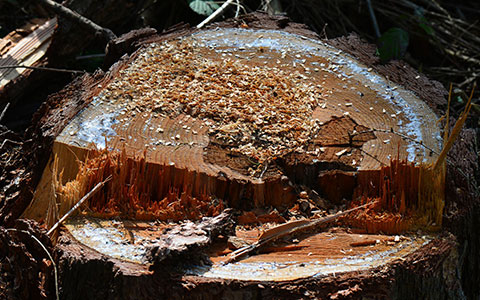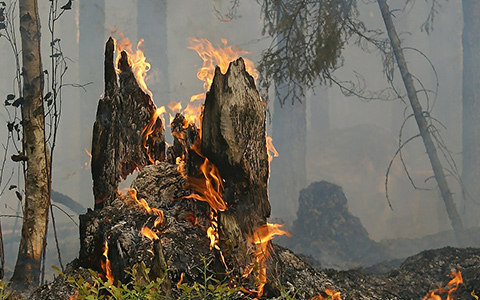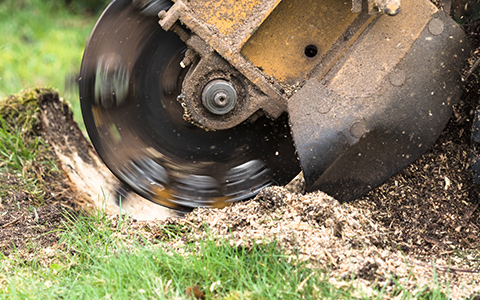
Is the tree you cut down trying to grow back from the stump? Many times, when trees get cut down, the stump and roots will continue to send out new growth. Knowing why they do this and what to do with it once the tree is gone can save you loads of time, effort, and money.
72tree.com assembled the following information on why trees grow back after being cut down, how to kill a tree stump, and remove it.
Yes, they can. That’s why it’s essential to be knowledgeable about tree growth when you need to remove one permanently.
Cut trees with enough stored sugars and nutrients in their roots can produce sprouts from the roots and trunk as a measure of survival and reproduction. The following species will commonly sprout after being cut down:
• Poplars
• Maples
• Lindens
• Boxelder
• Red Oak
• Willows
• Beech
• Ash
When this survival mechanism is triggered, single, or multiple sprouts may appear. If left unabated, these sprouts will grow into trees without having grown a stable root plate, and likely pose a much more immense falling hazard than the original tree.
Before you select a method to kill or remove a tree stump, evaluate the potential impact on the environment and immediate surroundings. The following are methods to eliminate tree stumps from sprouting:

Use Fertilizer for Rapid Decay – To accelerate the decaying process of the stump, do the following:
• Cut the stump to soil level
• Drill half-inch to inch-wide holes six to eight inches deep into the stump and aerial roots
• Apply a slow-release fertilizer to the holes and over the stump
• Cover and “mound” with soil
With little to no impact on the environment, this method is highly effective but takes several months to decompose the stump fully.
Note: In this and the following methods, areal roots are the large protruding “anchor” roots at the base of the stump.
Using Epsom or Rock Salt to Kill It – This process is one of the more economical, but takes several months to kill the stump. Apply this method by:
• Acquiring enough Epsom or rock salt to fill several deep holes and cavities in the stump
• Drill half-inch to inch-wide holes six to eight inches deep into the stump and aerial roots
• Pack the holes and any cavities with salt
• Use hot wax or another water-proof sealant to seal the holes and cover the cavities
• Secure a dark plastic tarp or trash bag over and around the stump to keep rain and sunlight out
In six to ten weeks, your tree stump should be dead and breaking apart.
Tip: While table salt will produce similar results, it is very harmful to the soil in the vicinity of the stump. Use only 100% Epsom or rock salt with no added ingredients.
Cover The Stump To Kill It – You can slowly kill your tree stump with this method, and it’s free.
• Secure a dark plastic tarp or trash bag over and around the stump to keep rain and sunlight out
Without adding any chemicals or salt, this method will take up to six months for the stump to die and start to decay.
While the tree is covered, there should be no growth. However, if sprouts do appear while the stump is still alive, cut them off.
Burn The Stump – Burning the stump is an effective way to remove it after it has died. The following steps will help you safely burn and remove your tree stump:

• Drill several half-inch to inch-wide holes six to eight inches deep into the stump and aerial roots. The deeper you can drill into the stump will ensure that it burns to the roots.
• Pour enough kerosene into the holes to thoroughly saturate the stump.
• Build a fire on top of the stump by placing scrap wood, twigs, and small logs on it. As the fire burns down, add more wood as necessary to keep the fire ablaze.
• When the stump has burned away, remove the ashes and replace them with soil.
As with any controlled burn, never leave it unattended. Keep a hose or fire extinguisher on hand in case the fire gets out of hand or begins to spread.
NOTE: Before using this method, consult your municipal ordinances to ensure that your controlled burn is legal, for more information call 411.
Tip: Turn the stump burning into a “bonfire” and invite friends and family over for an outside gathering.

Grind The Stump – Grinding the stump allows you to chop it up and remove it immediately. This method requires protective clothing and equipment and some knowledge of machinery operation and safety. The following steps will help you safely remove your tree stump:
• Use a chainsaw to cut the stump as close to the ground as possible, leaving a level surface
• Grind the stump and any areal roots until fully ground up
• Remove the wood chips (use them for mulch or discard them)
• Fill the hole with fresh soil
Keep children and pets at a safe distance while the stump grinder is in use.
Note: Before operating this or any other machinery, refer to the operating manual to ensure its proper and safe use. There may be safety features that you are not aware of on the machine.
Call A Professional Tree Service – Take all of the stress, equipment, time, and chemicals out of the process by calling a professional tree service to come out and remove your tree stump. They have specialized equipment and experience to remove your tree stump quickly and safely.
In this article, you discovered why trees continue sending up sprouts after being cut down, how to kill a tree stump, and how to completely remove one.
By killing and removing your tree stump, you are preventing sprouts from growing and creating a hazard to surrounding structures and people.
Allowing a tree to re-grow in this manner is significantly dangerous. These new trees grow without establishing a firm root plate and may topple as they increase in size without warning.
Sources:
umass.edu/urbantree/factsheets/26killastump.html
ucanr.edu/blogs/blogcore/postdetail.cfm?postnum=20662
warnell.uga.edu/sites/default/files/publications/Stump%20Removal%20pub_14-8.pdf